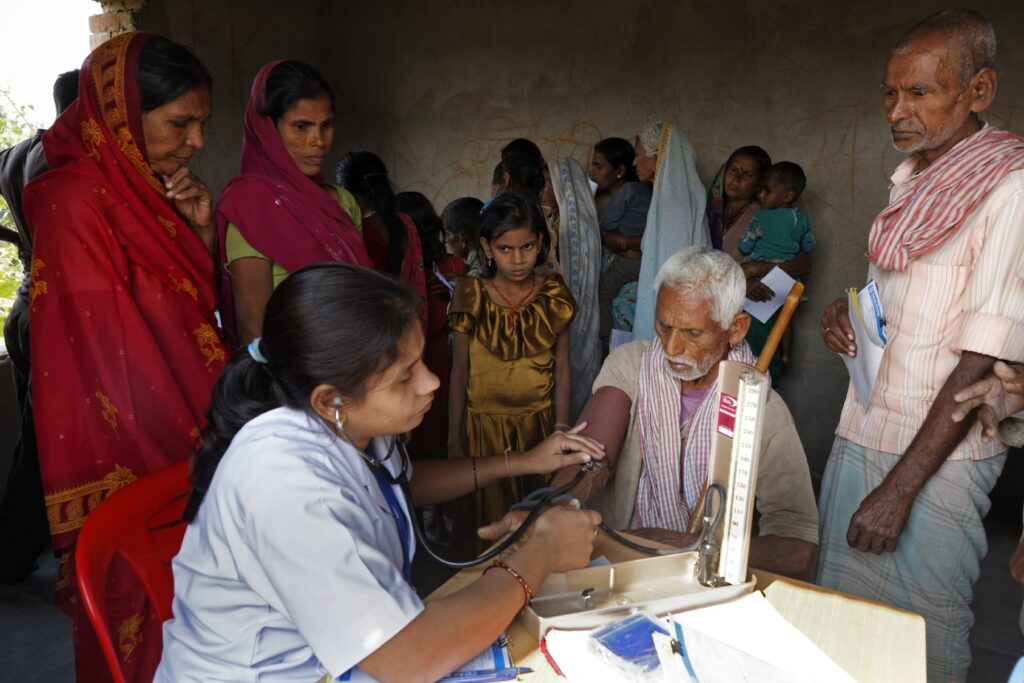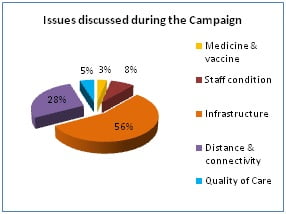Medical Awareness in Rural Areas
Rural Health care is one of biggest challenges facing the Health Ministry of India. With more than 70 percent population living in rural areas and low level of health facilities, mortality rates due to diseases are on a high.

Healthcare is the right of every individual but lack of quality infrastructure, dearth of qualified medical functionaries, and non- access to basic medicines and medical facilities only reach to 60% of population in India.
A majority of 700 million people lives in rural areas where the condition of medical facilities is deplorable.
In rural India, where the number of Primary health care centers (PHCs) is limited, 8% of the centers do not have doctors or medical staff, 39% do not have lab technicians and 18% PHCs do not even have a pharmacist.
India also accounts for the largest number of maternity deaths.
A majority of these are in rural areas where maternal health care is poor. Even in private sector, health care is often confined to family planning and antenatal care and do not extend to more critical services like labor and delivery, where proper medical care can save life in the case of complications.
Reality of Healthcare in Rural India

Healthcare is the right of every individual but lack of quality infrastructure, dearth of qualified medical functionaries, and non- access to basic medicines and medical facilities thwarts its reach to 60% of population in India. A majority of 700 million people lives in rural areas where the condition of medical facilities is deplorable. Considering the picture of grim facts there is a dire need of new practices and procedures to ensure that quality and timely healthcare reaches the deprived corners of the Indian villages. Though a lot of policies and programs are being run by the Government but the success and effectiveness of these programs is questionable due to gaps in the implementation. In rural India, where the number of Primary health care centers (PHCs) is limited, 8% of the centers do not have doctors or medical staff, 39% do not have lab technicians and 18% PHCs do not even have a pharmacist.
India also accounts for the largest number of maternity deaths. A majority of these are in rural areas where maternal health care is poor. Even in private sector, health care is often confined to family planning and antenatal care and do not extend to more critical services like labor and delivery, where proper medical care can save life in the case of complications.
The Problems
Due to non accessibility to public health care and low quality of health care services, a majority of people in India turn to the local private health sector as their first choice of care. If we look at the health landscape of India 92 percent of health care visits are to private providers of which 70 percent is urban population. However, private health care is expensive, often unregulated and variable in quality. Besides being unreliable for the illiterate, it is also unaffordable by low income rural folks.

Rural people in India in general,and tribal populations in particular, have their own beliefs and practices regarding health. Some rural people have continued to follow rich, undocumented, traditional medicine systems, in addition to the recognised cultural system of medicine such Ayurveda, Unani to maintain positive health and to prevent disease.
Infectious diseases dominate the morbidity pattern in rural areas Waterborne infections, which account for about 80% of sickness in India, make every fourth person dying of such diseases in the world, an Indian. Annually, 1.5 million deaths and loss of 73 million workdays are attributed to waterborne diseases.
Malnutrition is one of the most dominant health related problems in rural areas. There is widespread prevalence of protein, anaemia, vitamin A deficiency. The woman of rural areas don’t even know about the use of Sanitary Napkins, they use cotton for their periods day. And therefore most of them suffer from infectious diseases as well.
Improving Healthcare on the ground
To control the spread of diseases and reduce the growing rates of mortality due to lack of adequate health facilities, special attention needs to be given to the health care in rural areas. The key challenges in the healthcare sector are low quality of care, poor accountability, lack of awareness, and limited access to facilities. Various organizations are coming together for improvements in health care and technology plays a crucial role to facilitate this.
Information and communications Technology provides hosts of solutions for successful implementation of these changes. Several organizations are working alongside the government and NGOs to help relieve the burden on the public health system using mobile technology.
Campaigns for Healthcare Accountability
In association with Grand Challenges Canada, we conducted a Health campaign to review health services for accountability in Jharkhand. In this campaign on Mobile Vaani we invited opinions, experiences, information and feedback from public on current Government health facilities in Jharkhand.
People from different districts of Jharkhand left messages on various issues in health care facilities, such as; health facilities available at PHCs, Laboratory testing and Delivery facilities at Government Health Centers, availability of clean toilet and drinking water at PHCs, and distance of the nearest health center from the Village.

Within the first 4 weeks of the campaign, more than 1600 callers from 12 districts of Jharkhand called in and participated. Lot of important facts were brought forward in the campaign. 50 percent of the people informed that there was no facility of Laboratory Investigation or Delivery available at their nearest Health Centers. While a total of 86 percent callers shared that the facility of drinking water and public toilet was not available in the Government Health centers.
The campaign enabled us to:
- Understand the present scenario of health facilities in Jharkhand
- Identify major issues that people are facing while seeking health services.
- Review the state of PHC infrastructure and its connectivity to nearby villages
- Build awareness about accountability in health care
To bring about a change in the existing healthcare system we took the voices of people to the Government authorities. We collated data from our campaign and communicated the real picture to the district collectors and state health department for action.
Nice Writting Skil.